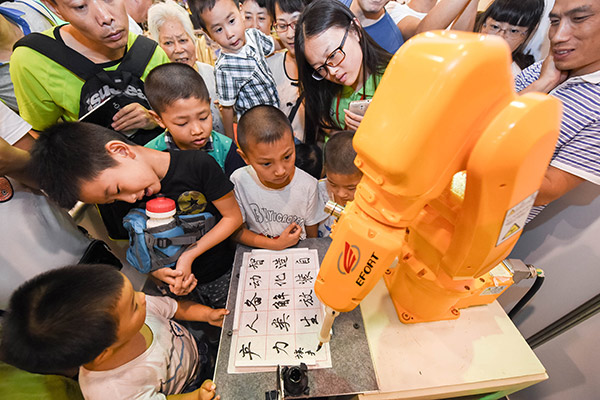
A journalist takes a selfie with a robot at the University of Science and Technology of China in Hefei, Anhui province.[Photo/Xinhua]
China plans to triple its annual production of robots used in the manufacturing sector to 100,000 in five years, an industry regulator said on April 26.
The target is being pursued as the country upgrades its labor-intensive manufacturing with technological innovation.
China is also aiming to sell more than 30 billion yuan ($4.6 billion) worth of service robots by 2020 amid surging demand in the healthcare, education and entertainment sectors, according to the Ministry of Industry and Information Technology.
The initiative details the growth of the robotics industry for the national 13th Five-Year Plan (2016-20) with a view to increasing the quality of equipment, said Xin Guobin, the vice-minister of industry and information technology. China produced fewer than 33,000 manufacturing robots in the past year, according to the ministry.
“The strategy will help the Chinese robotics industry to achieve healthy growth amid challenges from overseas providers,” Xin said.

A robot demonstrates precision by writing Chinese calligraphy in Hefei.[Photo/Xinhua]
China became the world’s largest market for industrial robots in 2013, surpassing Japan, according to the International Federation of Robotics.
The organization estimates that the country will continue to drive demand for various types of robots due to the automation of its factories and increasing demand for service robots in an aging society.
Increasing labor costs and labor shortages are pushing some manufacturers to adopt robots in product lines.
Feng Xisheng, an academic at the Chinese Academy of Sciences, said robots will be able to complete more complicated tasks in the future.
“The future of the robotics industry will be heavily overlaid with other technologies, including artificial intelligence and virtual reality. This will be the areas that local companies work on,” Feng said.
The ministry will also encourage Chinese robot manufacturers to gain a bigger presence in the high-end market, an area currently controlled by overseas giants such as Fanuc Corp from Japan and the multinational ABB Group based in Switzerland.

Robots from Sichuan University (left) and Southeast University show their soccer skills at the RoboCup 2016 China Zone competition on Tuesday in Hefei.[Photo/Xinhua]
Industry sources said this goal will fuel the growth of Chinese robot manufacturers such as Siasun Robot & Automation Co and Hubei Huachangda Intelligent Equipment Co.
Qu Daokui, president of Siasun Robot, China’s largest robot maker by market value, said the country’s robotics industry is still “like a toddler”, but is growing.
The company, eager to boost its competitiveness, is spending heavily on the research and development of industrial robot components.
“Most of these components are still imported from foreign countries, whose steep tariffs increase the cost of robots,” Qu said.
Siasun is planning to acquire competitive domestic and international component manufacturers after the Shenzhen-listed company raised 2.96 billion yuan from five institutional investors in November.
“We have been in negotiations with potential companies for more than a year, and we hope to complete the acquisitions by June,” Qu said, declining to give more details.
